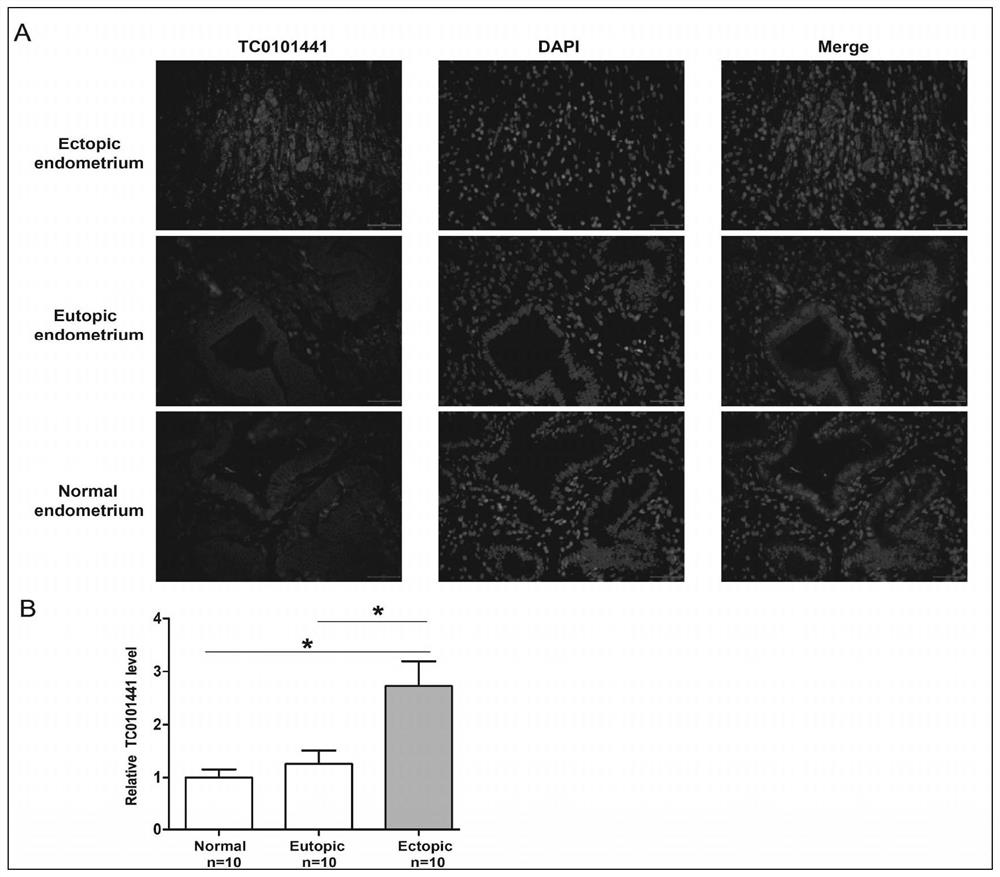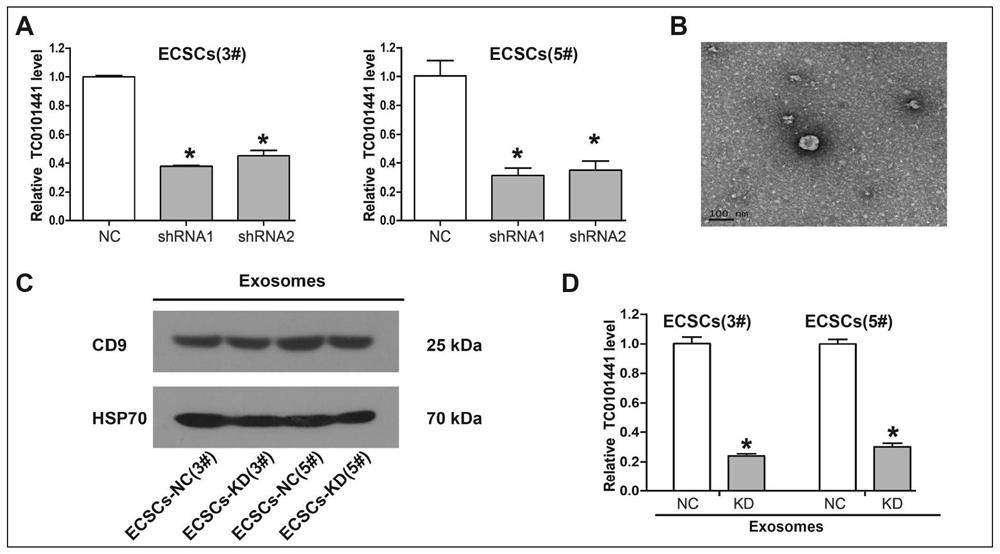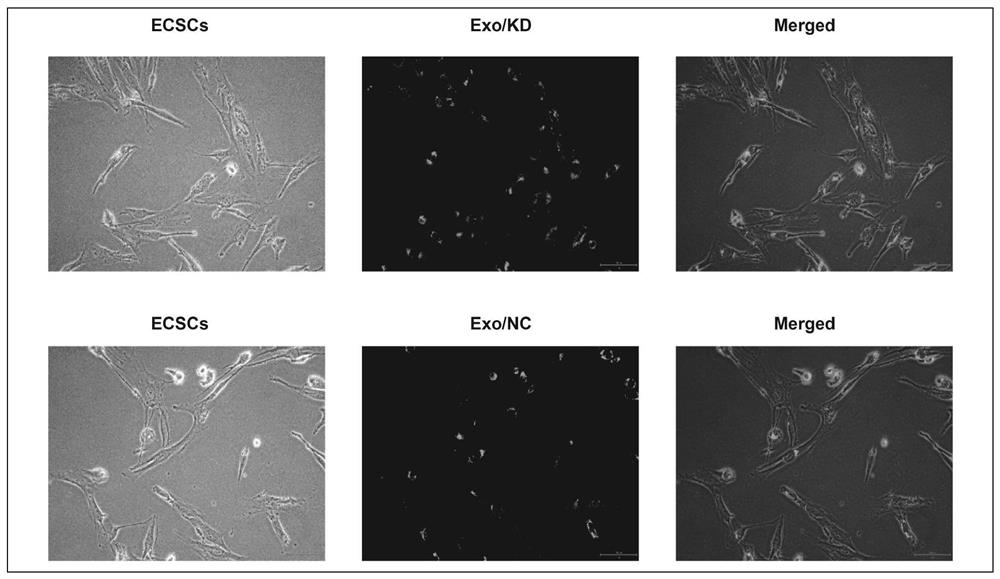Use of circulating exosomal long non-coding RNA-tc0101441 as a marker for the diagnosis of endometriosis
An endometrium, non-coding technology, applied in the field of medical detection, can solve problems such as the difficulty of early diagnosis of endometriosis, achieve the effect of promoting invasion and metastasis, and the technical effect is obvious
- Summary
- Abstract
- Description
- Claims
- Application Information
AI Technical Summary
Problems solved by technology
Method used
Image
Examples
Embodiment 1
[0015] Example 1 Expression of lncRNA-TC0101441 related to promoting metastasis in ectopic, eutopic and normal endometrial tissues in patients with endometriosis
[0016] Fluorescence in situ hybridization (FISH):
[0017] 1) Fix and dehydrate the ectopic, eutopic and normal endometrial tissue samples in endometriosis;
[0018] 2) The lncRNA-TC0101441 probe was added to the hybridization buffer, and the in situ hybridization kit (Biochain, Hayward, CA, USA) was used for in situ hybridization.
[0019] 3) After the nuclei were stained with DAPI, they were observed with a fluorescence microscope.
[0020] Expression of metastasis-promoting lncRNA-TC0101441 in ectopic, eutopic, and normal endometrial tissues of patients with endometriosis detected by real-time fluorescent quantitative PCR (qRT-PCR)
[0021] Detection process:
[0022] Real-time fluorescence quantitative PCR method:
[0023] The primer sequence is as follows: lncRNA-TC0101441:
[0024] Upstream primer 5'-caag...
Embodiment 2
[0034] Example 2 Extraction and identification of exosomes from the supernatant of ectopic endometrial stromal cells (ECSCs)
[0035] Cell supernatant exosome extraction and identification process:
[0036] 1) Primary culture of ectopic endometrial stromal cells (3# and 5# ECSCs) highly expressing TC0101441, and culture ECSCs in serum-free medium for 3 days;
[0037] 2) The expression of TC0101441 in 3# and 5# ECSCs was knocked down by siRNA and lentivirus knockdown (knockdown, KD) technology, and TC0101441 knockdown and control ECSCs were obtained.
[0038] 3) Use exosome extraction kit #44578259 (Thermo Fisher Scientific, CA, USA) to extract exosomes in the above cell supernatant.
[0039] 4) Transmission electron microscope (TEM) identification of exosomes: Take 20ul of the exosome solution obtained above, add 20ul of PBS to dilute it, drop it on the sample-loading copper grid dedicated to the microscope, place it at room temperature for 3 minutes, and dry it in the air ,...
Embodiment 3
[0042] Example 3 Exosomes secreted by donor ectopic endometrial stromal cells (ECSCs) supernatant were endocytosed by recipient cells
[0043] Exosome labeling and endocytosis experiments:
[0044] 1) Exosomes were labeled with green dye PKH67 (green dye, Sigma-Aldrich, St. Louis, MO, USA),
[0045] 2) The exosomes secreted by the supernatant of donor ectopic endometrial stromal cells (ECSCs) were co-cultured with recipient ECSCs, and the endocytosis of exosomes was observed by fluorescence microscope after 4 hours.
[0046] We found that: if image 3 As shown, exosomes released from the supernatant of TC0101441 knockdown and control ECSCs can be endocytosed by recipient cells, suggesting that exosomes and exosomes TC0101441 can be transported from donor ectopic endometrial stromal cells (ECSCs) to recipient cells.
PUM
| Property | Measurement | Unit |
|---|---|---|
| diameter | aaaaa | aaaaa |
Abstract
Description
Claims
Application Information
 Login to View More
Login to View More - R&D
- Intellectual Property
- Life Sciences
- Materials
- Tech Scout
- Unparalleled Data Quality
- Higher Quality Content
- 60% Fewer Hallucinations
Browse by: Latest US Patents, China's latest patents, Technical Efficacy Thesaurus, Application Domain, Technology Topic, Popular Technical Reports.
© 2025 PatSnap. All rights reserved.Legal|Privacy policy|Modern Slavery Act Transparency Statement|Sitemap|About US| Contact US: help@patsnap.com



